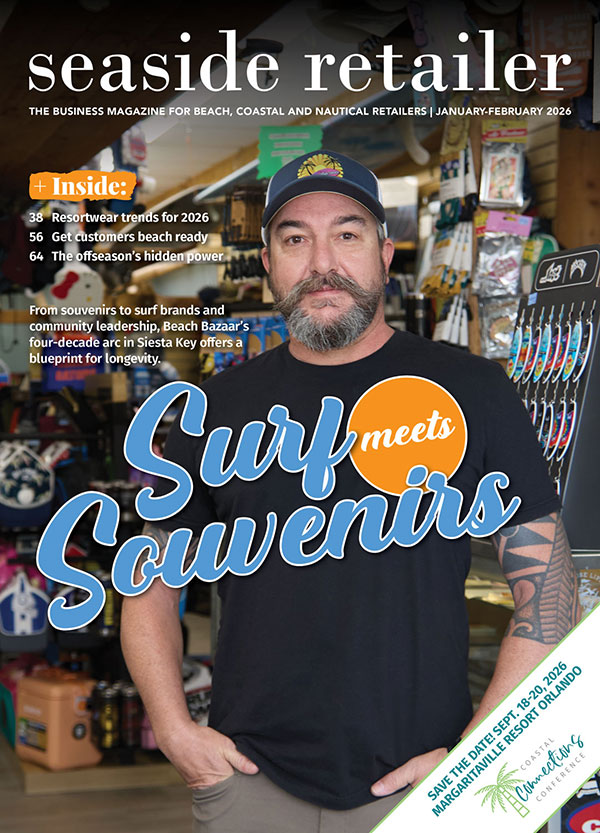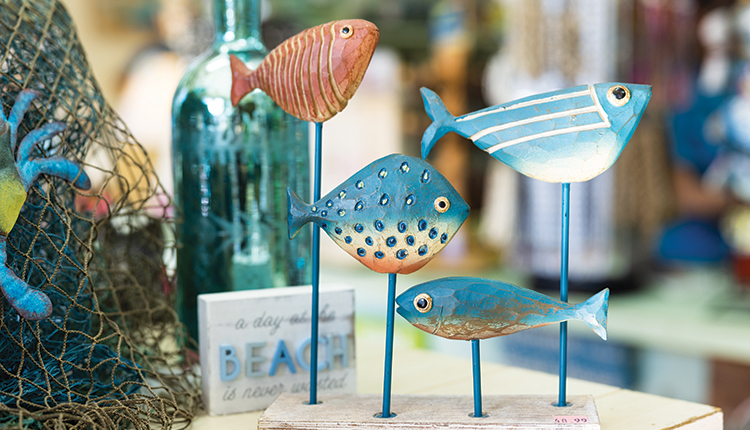
Take it easy — like a turtle. Swim in swirls free as a bird — like a stingray. Dip in and out of the waves like a dolphin. Cozy up and beach out on the sand — like a manatee that “looks like a lumpy teddy bear,” says Bryan Silver, owner of Just Beachy Gifts and Decor, located in Panama City Beach, Florida.
“People want to take home something that resonates with them and represents their visit to the beach — it’s about what they saw and experienced, and a lot of times that involves animals,” Silver says.
Sea animal product sales have climbed steadily at the store in recent years.
“I’d say about 95% of what we sell has some sea life animal, whether a charm, painting or picture, because there is nothing that identifies the beach more than the animals,” observes Silver.
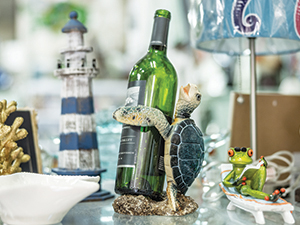
Also, the typical shopper’s taste has evolved. “They want more than a trinket with a location printed on it — it’s beyond an ashtray or shot glass and something that they can wear or display that brings back memories for them,” Silver says.
From jewelry to home decor, artistic sculpture to special plushies and better apparel, seaside retailers that incorporate sea animals into enticing displays are earning repeat business and ringing up sales from consumers who connect to water creatures.
“Maybe they feel it’s their spirit animal, or they saw it on a trip and are just excited about it,” says Rebecca Fordham, owner of Caloosa WaterWear, a Delray Beach, Florida-based wholesaler that sells apparel, accessories and drinkware.
Sea-ing is selling
Sea animal sales can vary by region. It all depends on what animals people can spot from their hotel balconies, their condos, on the beach or in the water.Retailers in the Sunshine State aren’t stocking up on baby belugas, for example. “People don’t come here to go whale watching,” Fordham remarks about Florida. People looking for whale merchandise are more likely to find it in the Pacific Northwest or New England.
Similarly, the lobsters in Florida, lack the iconic red color of their East Coast relatives and don’t make as appealing a memento on the Gulf Coast of Florida as they would in say Ocean City, Maryland. “It’s really important to make sure you are selling the right type of sea life for your area,” Fordham advises.
Yet, some lovable sea animals can sell — even hundreds of miles away from the shore. For instance, Tim Smith, owner, of souvenir wholesale company SJT Enterprises, says sea turtles are a perennial favorite and dolphins “sell well anywhere, throughout the country.”
The reason? “People just love dolphins,” Smith says. “Maybe it’s the mystery of them, and everyone thinks of dolphins as being so playful, nice and smart.”
Turtles, turtles everywhere
Across the board, wholesalers and retailers say the sea turtle is one of the most popular sea animals among consumers. It’s the best-selling jewelry category for Ocean Jewelry, according to Alan Clancy, sales executive for the collection’s parent company, Ireland-based Shanore Jewelry.“Turtles have such a universal appeal,” he says, calling out the slow and easy connotation. “The beach, for many, represents a place where time has no standing and we can unplug and relax. Also, turtles have a very strong maternal instinct as they go through so much to lay their eggs.”
Ocean Jewelry represents this instinct with its Mom & Baby sea turtle designs in the Ocean Jewelry collection. Starfish also appeal to a nationwide audience, Clancy says. Crabs and whale tail designs are in high demand in the Mid-Atlantic, he adds.
While turtles sell well in any market, they’re even more popular with seaside retailers whose shops are in close proximity to turtle nesting grounds, which is the case for Just Beachy Gifts and Decor. Dolphins are also attractive for this reason.
“People see them from their hotel or condo balconies,” Silver says. “And in the summer the water gets very clear and you can see sting rays flying around.”
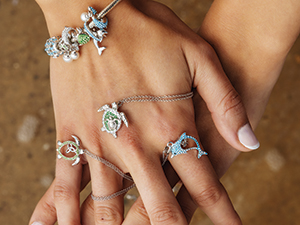
It’s not unusual for a shopper to say, “I just saw a sting ray and it was so amazing!” Then, he can point to a shelf of items.
Glass manatee ornaments disappear quickly at Silver’s shop, too. “When people from out of state see them, they are like, ‘I had no idea what a manatee was,’” he says of the unique sea creature that tends to strike a chord with visitors.
With the Florida location, other popular animals include flamingos, seahorses, starfish — and even parrots, sand dollars and seashells. Combining mermaids with animals is also an appealing duet. “We have a mermaid plush and she’s holding a baby dolphin or manatee under her arm, and those are a big deal,” Silver says.
Demographics dictate
Product type also can influence sea animal popularity. For example, Fordham says certain animals sell better on decor versus apparel or jewelry. “An octopus looks O.K. on apparel, but on a pillow cover, it sells amazingly,” she says. Caloosa WaterWear also makes octopus-themed coasters and decorative pillows that “sell like crazy on those items.”Products featuring sea animals speak to different age groups. Pop culture can come into play, notes Fordham.
“For the little ones, with the Baby Shark trend, sharks do really well on kids’ items,” she says, referring to the popular “Baby Shark Do Do Do” song.
Caloosa WaterWear is launching a tarpon print that Fordham expects to do well with male clientele.
First-time mothers and grandmothers appreciate the mom-and-baby pieces, Clancy says, and simple turtle, dolphin and starfish studs sell well to younger girls.
Just Beachy appeals to grandparents buying children’s gifts and the youngest shoppers with a section that includes plush toys, books for early readers and jigsaw puzzles.
“They can give the kids a book and let them learn about sea life or shells, or enjoy an old-fashioned puzzle,” Silver says. Just Beachy stays away fr om pop-culture items and known brands, preferring instead to carry artisan items like metal sea animal sculptures that stand 4 to 6 feet tall. He entices guests into the door with an outdoor display of the colorful outdoor art.
Shoppers mainly range from age 30 to 55 and are looking for sea animal decor.
“They’re buying things for their homes,” he says of a desire for housewares.
Displays are refreshed frequently, and Silver says he avoids bulking up on too much of one item so he can offer consumers variety.
“Every time they come in, we have a different selection and displays,” he says. “They will say, ‘Two summers ago, I got this giant seashell light, and this will look great next to it.’ I get the sense that they are creating a vacation diorama.”
Using ‘animal’ instincts
When building out a diverse sea life product offering that appeals to a range of customers, consider display presentation, product pairing and branching out to include something sea animal for everyone.While there is some regionality to sea life sales, Brad Holes, owner of plush toy company, First & Main, says a measure of increased demand for sea animal products is the fact that shops across the country are selling it.
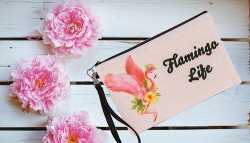
First & Main’s most popular sea life plush lines are its Fanta Sea and Under-the-Sea collections. “All of our product lines are made to be fun, colorful and whimsical,” Holes says.
Just as teddy bears have a universal appeal, so do sea creatures, he points out. Retailers that expand their offering are ringing in more sales. For example, aquariums will sell more plush sea animals representative of exhibits and experiences. But other products do well, too. Hole says this is because as humans, we develop anthropomorphic relationships — affection or and connections with inanimate objects we find appealing. With plush product, “they’re cute, they look friendly, and the character is something kids want to take home because it has personality,” he says.
First & Main is expanding its sea life product options with a collection in 2022 with fresh characters. “Stay tuned,” Hole says.
As for presentation, mindful product placement will encourage interest — and promote sales. “Display makes all the difference,” Holes says.
For example, he says, while plush products can be displayed on wire racks, shelving is more effective so guests can see and touch. “That way, customers can scan to the left and right to look at displays, products are separated from each other or displayed face out and they can zero in on the cuteness.”
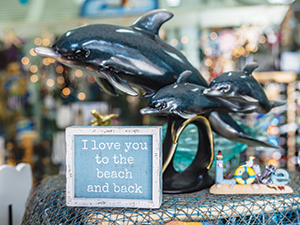
Plush paired with T-shirts is a natural arrangement. “We also have sold shirts that coordinate with plush as a way to create multiple sales for retailers — but whether with our shirts or others, it completes a department of products that I think beach shops are expected to carry,” Holes says.
Testing the waters
Considering which sea life products to carry? Silver likes to test inventory by purchasing small numbers. Also, he displays products on shelves that feel like the built-ins that consumers might have at home.Because more of us are entertaining at home and dining outdoors, Amos Kauffman notices “a huge uptick in demand for nautical product,” particularly lawn decor along with tabletop accoutrements like napkin holders and bottle openers, which includes the popular crab and octopus designs. The owner of Beaver Dam Woodworks in Honey Brook, Pennsylvania, says lighthouses are popular, and a longtime seller in the animal category is the company’s whirly birds — available in flamingos, egrets, pelicans and more. Notably, Beaver Dam offers The Sea Quest Collection of lighthouses, windmills, wishing wells, sailboat planters, rowboat bookshelves and more, which have experienced increasing sales. In general, Kauffman says coastal, including animal products, have been “very popular since COVID, with more outdoor living going on.”
Jewelry presents opportunities to generate solid margins, Clancy adds. Plus, it’s “always on trend,” he says. “Sea life jewelry can create meaningful memories for customers who will more than likely return to make additional purchases with each visit to your store.”
The timeless nature of sea life and the emotional tug it provokes when consumers find just the right memento are reasons why retailers are finding success with products featuring one of the many beloved creatures. Clancy says, “In a world where we are being bombarded with the latest ‘this, that and the other,’ sea life is a classic and anything depicting a sea life motif simply just puts a smile on your face.”




